AI has a huge impact on how you and your organization will create content, share information, and reach your stakeholders. In 2022, ChatGPT broke all user growth records by getting 1 million users in just 5 days after launch. Today, ChatGPT alone receives 5.4 billion monthly visits and only 20% of people report not using AI at all, with 35.4% of AI users using the tools daily. And they’re using it not just to generate content or to solve problems; they’re increasingly using it for researching answers to questions and for recommendations.
According to SEMRush, zero-click searches are now used by 80% of users for at least 40% of their searches globally. Additionally, almost 90% of queries that triggered an AI summary are informational. However, a recent study showed that the presence of an AI overview in search resulted in 34.5% lower clickthrough rate (CTR) for the top-ranking pages in those results. Another study from Brightedge confirmed this trend showing that year-over-year, search impressions were up by 49%, but CTRs fell by 30%. Simply stated: If users are now relying on AI summaries, they’re no longer clicking to your website, the earned media you’ve secured, your owned content, or your social content – at least not directly.
It’s not all doom and gloom; with all changes there are winners and losers, but there’s always opportunity.
What is GEO (and why should PR teams care)?
Before we go further, here’s a quick breakdown of the differences in the acronyms you’re likely seeing out there today:
- Generative Engine Optimization (GEO): Ensuring generative AI systems (ChatGPT, Gemini, Perplexity, etc.) reference, summarize, and attribute your brand correctly in answers to user questions.
- Answer Engine Optimization (AEO): Helping engines like Google and Bing surface your content in direct answers and featured snippets — no clicks required.
- AI Optimization (AIO): The umbrella strategy that includes GEO + AEO, along with measurement, data orchestration, and content structuring to protect your brand’s accuracy and authority across AI interfaces.
Together, these represent a shift from ranking in search results pages to being a trusted source in AI-generated answers.
Why PR is More Valuable Than Ever
So, what does that mean for you as a communicator? It means your work is valuable and potentially gaining in value over time. Why? Generative AI favors:
- Neutral, credible content
- Authoritative sources
- Community-validated information
- Fresh, structured context
AI pulls from trusted neutral sources. It avoids overly promotional and paid content. Platforms like Reddit, Linkedin Wikipedia, YouTube, and Medium dominate mentions and citations in LLMs. But go down the list a little further and you start to see media publications, like Forbes and Techradar – and even press release distribution sites. In other words, when you get outside of social and community sites, communications media sources show up frequently in citations. Earned media is finally getting the visibility and weight it deserves.
This probably isn’t news for you, though. GEO is hot right now. And yes — the hype has invited a flood of quick-fix vendors and vague promises. But communicators need real clarity on what actually works — and what needs to change.
This blog is the first in a series that will break down what PR teams must know to influence AI search, track results, and build a future-proof strategy to build credibility and mindshare in AI generated responses (I’ll keep the AI-buzzwords to a minimum to save your sanity — I promise).
How AI Search Actually Works (The simple version)
Traditional search engines match keywords, links, and ranking signals. AI systems do something different:
- They use semantic search (vector search) — finding content based on meaning, not exact phrasing.
- They combine retrieval + generation (RAG) — pulling from multiple sources to construct an answer that is factual and grounded.
- They weigh freshness, expert authority, and completeness more heavily than backlinks or keyword density.
So instead of sending users to the “best link,” generative search synthesizes the most relevant, trustworthy, and current information it can find and references trusted credible sources to base it’s response.
And that’s where PR-driven credibility becomes essential.
Structuring Content for Inclusion:
To be part of the results, though, it’s important that you write and target organic mentions that will match the intent of the query. For communicators like you, this means writing with clarity on what question the audience might ask—and making sure your content answers the intent with clear and organized structures that are technically sound and easy for AI to reference.
To surface in AI-generated answers, your content — and the mentions you earn — must:
- Clearly answer the questions your audience is asking
- Use simple, direct language
- Be structured for easy parsing (headlines, bullets, definitions, FAQs)
- Cite credible sources
- Live on technically sound pages (clean URLs, alt text, metadata, schema)
The goal: make your insights easy to extract and confidently cite.
If your content meets the intent of a user query, generative search can feature your brand — even if you’re not winning traditional SEO rankings.
Community Matters:
In the world of GEO, community content, social signals and organic references still play a role like they did in traditional SEO.
That means community engagement is still a powerful lever: Generative systems still look at source authority, trust and linkage. So, PR-driven mentions and engagement on sites like Reddit, Quora, Instagram, X, and TikTok help. PR teams, like you, can lean into this by building forums, community FAQ content, interviews, podcasts and guest posts that lend credible context and help build your brand as an authority.
Why is GEO a Long Game for PR and Comms?
Simply stated: the signals to AI matter here, and that trust, relevance and credibility can’t be built over night. To win in generative search, PR must:
- Keep content fresh and accurate
- Build consistent authority across sources
- Target citations and mentions that add credibility
- Think beyond one-time press hits and toward accumulated influence
In other words, AI is basically Sting, now: every article you make, every expert quote you place, every trusted source you chase — AI will be watching you (hopefully).
How do you build the strategy and plan for this long game? Our next blog will share some concrete recommendations and strategies to focus your efforts, collaborate with your larger teams, and build toward long term success with some near-term wins.
By Brendon O’Donovan, SVP of Product Solutions and Innovation, PublicRelay
As the holiday shopping season approaches, affordability is once again at the center of retail media coverage. But this year, it’s taking on a different tone. PublicRelay’s analysis of earned media coverage for Amazon, Target, and Walmart from April through October 2025 reveals that affordability is no longer just a pricing story. It’s become a narrative about consumer survival, corporate responsibility, and strategic positioning in a volatile economic climate.
What’s Driving the Conversation: Sales Events, Tariffs, and Shifting Behaviors
Across all three brands, discount and sales events (such as Amazon Prime Day) generated the highest potential reach among affordability-related themes. With 52 million average potential impressions, these events are clearly where media and consumer attention converge.
Meanwhile, narratives about tariffs influencing pricing strategy and consumers seeking more value through memberships and early shopping continue to gain traction. This points to a growing awareness among journalists that affordability is more about the broader economic factors shaping how retailers plan, price, and promote than just about markdowns.
A Subtle but Significant Signal: Affordability and Health
Interestingly, while mentions of “affordability and health” were relatively few, they were the most widely syndicated theme, picked up by 46 outlets on average. This indicates that stories connecting price sensitivity with wellness or sustainability resonate strongly with syndicating publications, amplifying their visibility.
For communicators, this presents both an opportunity and a caution. Consumers and the journalists who influence them are increasingly scrutinizing what “affordable” means. Communicating discounts on healthy, sustainable, or responsibly sourced products will land far better than those tied to disposable or low-quality goods.
What This Means for Black Friday Communications
With consumer fatigue around endless promotions already setting in (CNBC reports “discount burnout”), retailers can’t afford to treat Black Friday like business as usual. Our data suggests this year’s event will be framed less as a celebration of deals and more as a reflection of economic reality. It will be a moment for retailers to demonstrate empathy, transparency, and purpose in how they communicate value.
Communications leaders should prepare for:
- Heightened media scrutiny of pricing tactics amid ongoing tariff impacts (as Retail Brew notes).
- Consumer skepticism toward excessive discounting or “deal fatigue.”
- Greater visibility for messaging that aligns affordability with health, sustainability, and long-term value.
Competing on Principles
Black Friday 2025 isn’t just about competing on price. It’s about competing on principles. Retail communicators who acknowledge the pressures consumers face, highlight the value behind their discounts, and position affordability as part of a responsible brand promise will be best positioned to win trust and strengthen reputation this season.
By Kay Kavanagh, Director of Research, PublicRelay
The PRDecoded 2025 conference in Chicago brought together the industry’s sharpest minds to explore one urgent theme: how communicators can navigate uncertainty in an era of accelerating change.
Below is a summary of the sessions I attended and a breakdown of the messages I subsequently took away from the event.
Across sessions led by agency leaders, brand executives, and researchers, I found one message expressly clear: the rules are being rewritten, and PR is better positioned than ever to lead.
1. PR’s Defining Moment Has Arrived
The opening “State of the PR Nation” conversation between Richard Edelman of Edelman and Chris Foster of Omnicom PR Group set an assertive tone.
Edelman made an impassioned call for communicators to seize what he called “PR’smoment”. By which he was saying the rise of earned influence in AI-driven search. With Large Language Models (LLMs) pulling heavily from earned and organic media, PR has a measurable impact on reputation and revenue. Reputation driven from earned media is now the lead.
Foster echoed this sentiment, emphasizing that communicators must understand business fundamentals as deeply as they understand storytelling. “We own the story, and the story is the strategy,” he said, urging PR pros to lean into technology, not fear it.
Both agreed: this is not a time for timidity. It’s a time for PR to demonstrate its elasticity, its fluency in technology, and its ability to connect earned narratives directly to business outcomes.
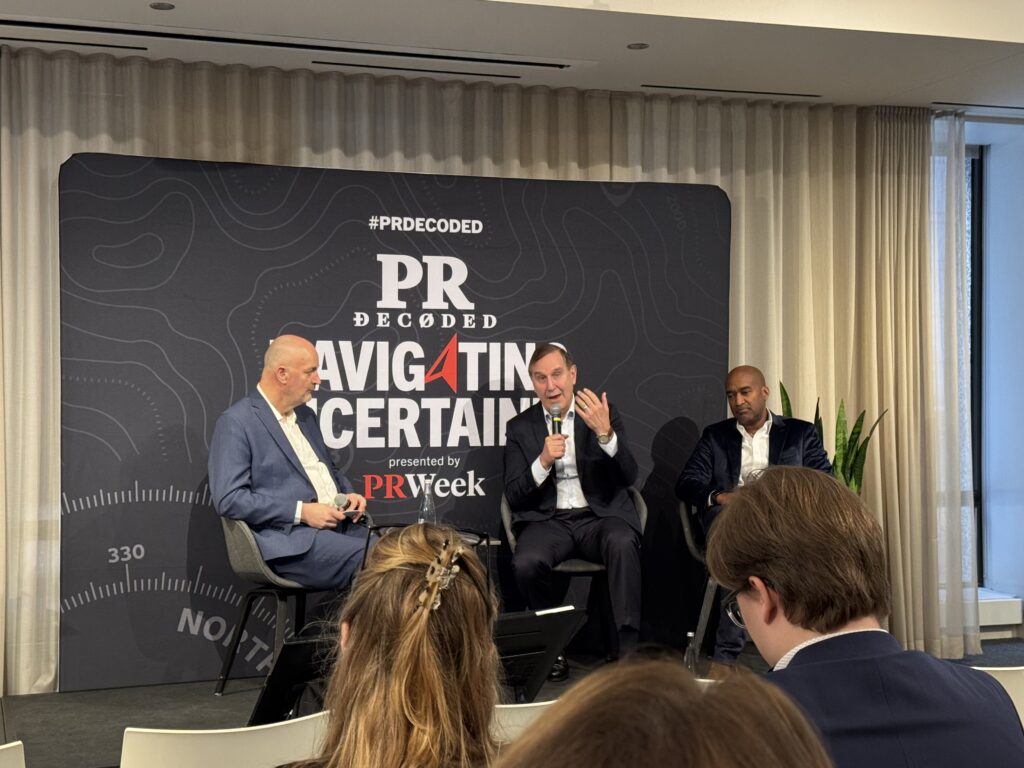
2. Rebuilding Trust in a Skeptical World
In a panel on: Building Brand Trust in an Era of Skepticism, leaders from Feeding America, Conagra, and Allison shared a stark reality: trust is the most valuable — and fragile — currency brands hold.
Monica McCafferty of Feeding America argued that rebuilding it starts with authenticity. Conagra’s Jon Harris underscored the need to earn and sustain stakeholder trust consistently, noting that in an age of transparency, words alone no longer suffice.
The takeaway? As optimism fades in Western democracies, communicators must play a central role in restoring belief not through messaging spin, but through actions that align with brand purpose.
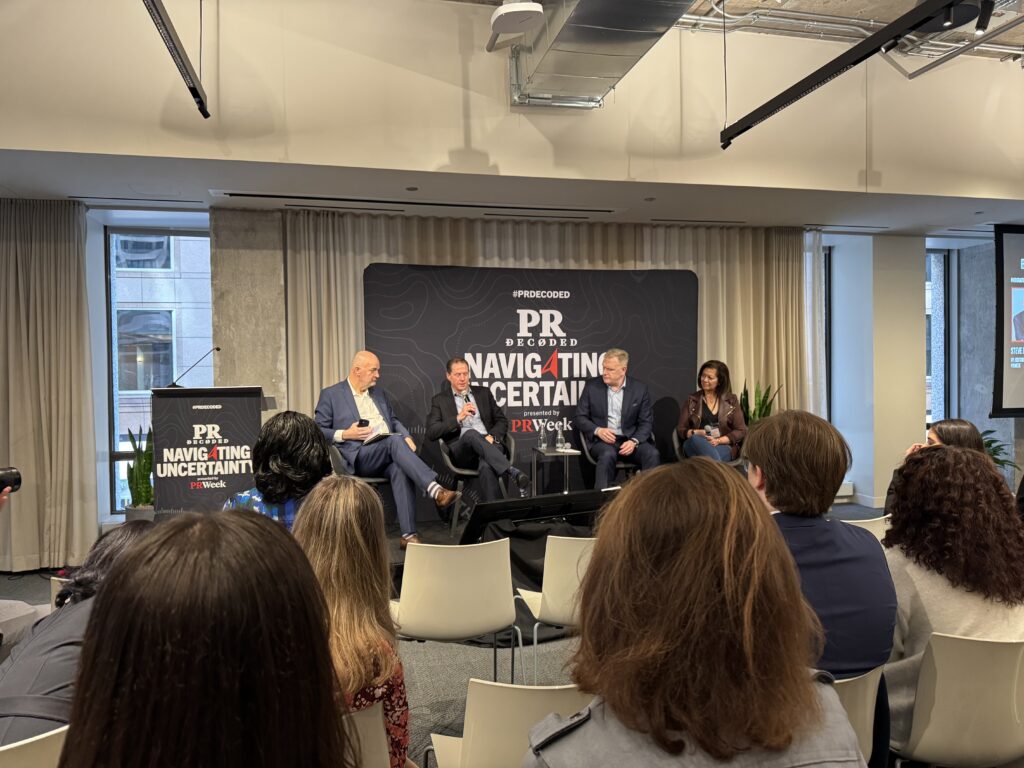
3. AI Is Reshaping the Communications Ecosystem
Several sessions reinforced that artificial intelligence is the next evolution of our craft, not the enemy
From Glenn Frates of PR Newswire calling for “information releases” structured to serve both human and machine readers, to Eileen O’Neill of Culligan reminding brands to “use data in smart ways,” the core message seemed to be: AI changes not what we say, but how we deliver and contextualize it.
Perhaps most eye-opening was Rob Bernstein of Ketchum’s presentation on Harnessing the Power of Search in the Era of Generative AI. He highlighted that GenAI represents the fastest technology adoption in history — 100 million users in two months — and it’s already redefining discovery.
In this “no-click search” world, GenAI doesn’t send people to your website; it becomes your website. Bernstein called it “the most powerful influencer of reputation,” urging communicators to analyze which stories are feeding algorithms and to optimize for visibility and sentiment.
His advice: Analyze → Interpret → Optimize. Because if you don’t answer questions about your brand, AI will, though you might not like the results.
4. Data Is the New Language of Reputation
In the Guardians of Reputation session, ADM’s Brett Lutz and Carma’s Orla Graham discussed how data is reframing reputation management.
Younger audiences, Graham noted, are deeply influenced by brand values. According to her, they don’t just buy products; they buy alignment. Lutz shared how ADM’s communications team uses data to make rapid strategic pivots, from reacting to political comments affecting corn prices to tracking how GenAI portrays their brand in search.
Similarly, in the session Reputation Is Currency, speakers described how their teams are investing in analytics and predictive modeling to quantify the business impact of communications,, underscoring how insights infrastructure now directly supports C-suite decision-making.
5. The Evolving Role of the CEO as Chief Communicator
The CEO as Lead Communicator panel and Kevin Warren’s keynote, Leadership and Aiming High, underscored the modern CEO’s role as a communicator first, operator second.
Warren, President & CEO of the Chicago Bears, shared how his decision-making philosophy, “player safety first” during the Big Ten’s pandemic-era challenges, stemmed from values-based clarity. Similarly, Monosol’s leaders spoke about agility and proactive signal detection as key to navigating crises like the “Tide Pod Challenge.”
The throughline: CEOs must not only embody transparency but also rely on communications teams who can sense emerging risks before they surface.
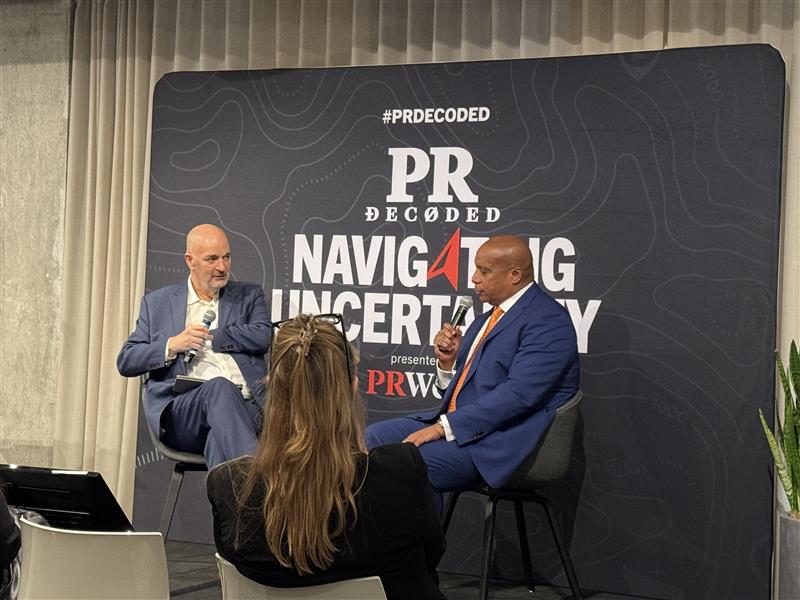
6. Strategic Responsiveness Is the New Crisis Playbook
In Cultural Flashpoints and the C-Suite, BMO’s Laura Micheli and Northwestern’s Jonathan Copulsky reframed crisis management as an ongoing cycle of intelligence and adaptation.
Copulsky drew parallels between brand resilience and military counterinsurgency strategy, emphasizing prediction, learning, and iteration rather than one-off crisis containment. Micheli shared how BMO’s culturally attuned campaigns, like #LoudBudgeting, turned potential financial anxiety into empowerment and relatability.
In summary: agility and foresight are foundational.
7. Influencers and Audiences Are Co-Creators of Trust
Finally, the Influencer Marketing Is the New Media session challenged the traditional view of influence.
GM’s Jessica Carmona and Burson’s Vikki Chowney argued that today’s most powerful influencers aren’t always celebrities.They’re the people who understand content and audience psychology. Chowney emphasized the importance of shared values and co-creation, while Reddit’s Adam Seligson noted that each platform requires a tailored, value-driven approach.
Basically, audiences can tell when brands “show up” authentically and they reward it.
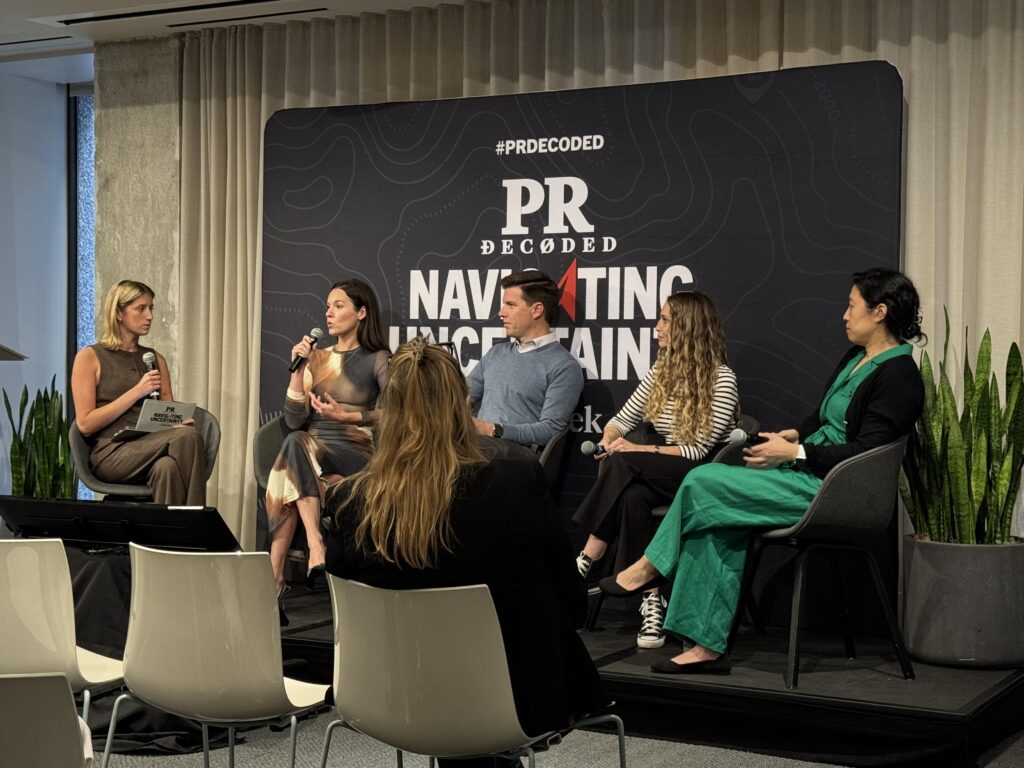
PR Must Lead Through Change
PRDecoded 2025 made one thing clear: uncertainty is not the enemy, but complacency sure is.
Communicators are the guardians of reputation, the architects of narrative truth, and now, the stewards of how AI perceives our brands. The future belongs to those who blend creativity with data, courage with curiosity, and empathy with precision, and as partners to communicators, we’re ready to help.
This is PR’s moment to lead — not by reacting to the world’s uncertainty, but by shaping what comes next.
By Jim Key, VP of Enterprise Solutions, PublicRelay
Halloween is approaching, and for communications leaders, the things that go bump in the night aren’t ghosts or goblins. No, what more often fills them with dread are headlines that spiral out of control, AI-written narratives that sound just a little too synthetic, and executive teams that want impact yesterday.
Over the past two months, PublicRelay has hosted roundtable discussions with senior communications leaders across industries. The conversations revealed that while comms professionals may sleep with one eye open, they’re also sharper, more strategic, and more indispensable than ever.
Here’s what’s keeping them up at night.
1. The Nightmare of Reputation Risk
“Reputation protection is the new risk management,” one participant shared. Nearly every conversation returned to this theme and the sense that reputation is no longer an abstract concept but a quantifiable business asset.
For many leaders, the line between crisis and credibility is razor-thin. The news cycle moves at a breakneck pace, and so does misinformation. Whether it’s a data breach, a leadership change, or a public policy issue, the first few hours matter most, with the communications function most often standing as the first line of defense.
Reputation may never sleep. Neither, it seems, do the teams protecting it.
2. The AI Apparition: Trust in the Age of Machines
If there was a clear chill in the air during these discussions, it came from one word: AI.
While many leaders acknowledged its efficiency, several worried about what one called “computers talking to computers”, a process that risks eroding human trust. Others discussed how their organizations are exploring Generative Engine Optimization (GEO) (optimizing for AI-generated summaries and responses) but admitted it’s a landscape currently defined by panic and uncertainty.
One communicator summed it up perfectly: “We’re trying to figure out how to differentiate our human insights from what AI can do. That’s our edge.”
The consensus? AI isn’t replacing the communicator, but it’s forcing a redefinition of what credible, human-centered communication looks like.
3. The Shapeshifting Media Landscape
The days when traditional media was the only game in town are long gone. Yet, many executives still crave that front-page Wall Street Journal coverage. Communications leaders have been juggling a three-headed monster: earned, owned, and paid media, trying desperately to make them play nicely together.
Podcasts and video content have emerged as rising stars, offering direct access to niche audiences. But as one leader shared, “Our first podcast sounded like we were talking to ourselves. We had to learn how to make it a conversation.”
Another leader described a cyber incident where the comms team took control of the narrative by first publishing a transparent internal memo, then a technical blog, and finally an external statement. The approach turned a potential crisis into a case study in responsible crisis mitigation.
The moral of the story is that those who control their own channels hold the flashlight in the dark, cobweb-filled hallways of ‘media’.
4. The Friction Between Functions
For many, the most unsettling shift is internal. Comms teams are increasingly merging with marketing, HR, and even legal. That’s created both collaboration and confusion.
Some noted a trend of Chief Communications Officers reporting into HR. This is a move that sparked anxiety about the perceived value of communications within the organization. “It depends on the CEO,” one leader said. “But no matter where you sit, you have to prove your impact.”
Measurement, once a “nice-to-have,” has become the silver bullet. Teams are tracking not just sentiment and awareness, but how their work drives trust, engagement, and retention, because these are metrics executives can actually take to the boardroom.
5. The Emotional Toll of Leading Through Uncertainty
Communicators are the steady hands in times of chaos, but they’re human, too.
In crisis moments, leaders described relying on “mindfulness” as their anchor. “It starts with a deep breath,” one said. “How we respond impacts how everyone else responds.”
Others spoke of balancing empathy with authority and being vulnerable enough to say ‘I don’t know,’ while confident enough to guide others through ambiguity.
One leader shared a team motto that’s apt for the profession: “Swim like a duck: calm on the surface, paddling furiously below.”
The Final Fright (and Hope): Community
For all the anxieties, there was a shared sense of relief in hearing “you’re not alone.”
Communications leaders today are navigating more volatility than ever, but they’re also finding strength in collaboration with peers, with data, and with their own sense of purpose.
So, what’s keeping communications leaders up at night?
The same thing that keeps them motivated each morning: the knowledge that their words, choices, and instincts shape the reputation of the organizations they serve.
Join one of PublicRelay’s upcoming events to find your own community moment.
By Alyson Atwell, Director of Marketing, PublicRelay
For years, the gold standard of media relations has revolved around securing placements in top-tier outlets – the New York Times, Washington Post, Wall Street Journal, and their esteemed peers. The logic was sound: these publications offered unparalleled reach, credibility, and influence. And, all things equal, traditional search ranking was boosted most by the bigger publications. But what if the ground beneath that strategy is shifting thanks to the rise of AI and a little-understood factor of Gen AI Engine Optimization (GEO) strategy?
We’re seeing compelling evidence that the influence of these traditional titans, while still significant, is no longer the sole determinant of success. The media landscape is fragmenting, and a new power player has entered the arena: AI.
The Hidden Influence of Smaller Publications
AI models like ChatGPT, Gemini, Claude, Perplexity, and others don’t just skim headlines when they consume information; they ingest, analyze, and synthesize the full text of sources the model recognizes as authoritative and credible, especially news sources. And herein lies the critical distinction: for many of these powerful AI engines, full text access to premium, paywalled publications like the NYT, WaPo, or WSJ is often limited or non-existent.
This creates a fascinating dynamic. While your hard-earned placement in a major daily might still generate buzz within human circles, its impact on what an AI model considers authoritative or relevant could be surprisingly muted. Conversely, trade publications, industry blogs, and even smaller, regional outlets – often with more open access policies – are being devoured whole by these AI platforms.
Adding a layer of complexity to this framework is that the search engines, publishers, and content producers are entangled in a web of legal gray area, with each protecting its own interests. Axios recently reported on the intricate web of licensing deals and lawsuits in this space, while Cloudflare is rolling out a pay-per-crawl tool to enhance content protections and make it harder (i.e. more expensive) for AI models to consume that content. In other words, the sources AI models access are a constantly moving target.
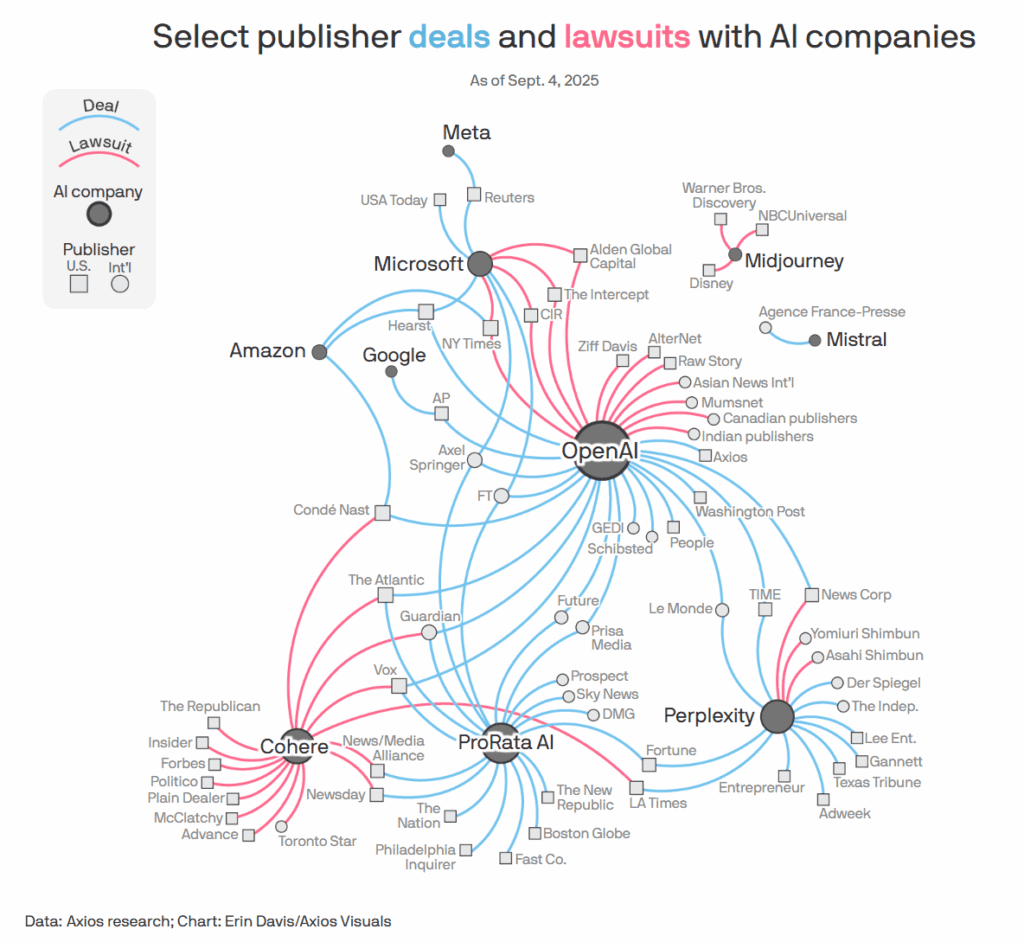
What this all means for Comms teams is that when a user queries Generative AI or even Google for information related to your industry, brand, products, services, leadership, etc. the answers they receive are increasingly being shaped by the outlets these AI models can fully read and process. If your key messages are locked behind paywalls, they’re essentially invisible to this growing and incredibly influential segment of information consumption.
The GEO Strategy: More Than Just Keywords
Beyond content access, there’s another subtle but powerful force at play: GEO strategy. This refers to the geographic and local optimization that AI engines are increasingly employing. For certain types of queries, particularly those with a local or specialized bent, an AI might prioritize content from sources geographically closer to the user or those with a demonstrated focus on niche topics.
This further reinforces the idea that a blanket “top-tier only” approach is becoming outdated. A highly relevant, well-researched article in a respected trade publication, even if it has a smaller traditional readership, could hold more weight with an AI than a broad-stroke piece in a national daily that isn’t as specifically tailored to the AI’s contextual understanding.
Time to Rethink: Prioritizing the Trades and Niche Outlets
So, what does this mean for your media strategy? It’s not about abandoning top-tier media entirely, but rather about recalibrating your priorities and expanding your focus. Your new top-tier should include:
- Key Trade Publications: These are often the authoritative voice within your specific industry, and critically, many have more open access policies for AI.
- Industry Blogs and Online Communities: Where your stakeholders are actively engaging and discussing relevant topics.
- Specialized Newsletters and Research Platforms: Often overlooked, but highly valued by specific, influential audiences.
The Challenge: How to Identify the Outlets that Actually Move the Needle?
At PublicRelay, our philosophy is rooted in using quality data from varied and trusted sources to answer these and other tough questions Communicators face.
Our robust outlet analysis approach goes far beyond traditional metrics like circulation to map out the best outlets and journalists to prioritize, given your specific business goals.
We combine:
- Psychographic and Demographic Data to pinpoint precisely which stakeholders value which outlets and why, so you can customize messaging accordingly;
- Sharing Data to evaluate how content from different sources truly resonates and spreads;
- Accurate Sentiment and Topic Analysis to ensure your messaging is landing effectively and driving the right conversations; and
- GEO Analysis to surface those secondary outlets that ChatGPT and others prioritize, so your messaging breaks through in search responses.
This holistic approach enables us to deliver truly targeted media lists that propel all of your goals: reaching your stakeholders where they are with the right messaging, including ensuring your voice is heard and understood in the increasingly influential AI engine results.
Don’t let an outdated media strategy leave you behind in the age of AI. Let PublicRelay help you craft a forward-thinking, data-driven plan that ensures your messages are not just seen but truly absorbed by both human and artificial intelligence.
Author: Liz Hogan, Senior Sales Engineer
Media coverage of CEOs has become an important proxy for corporate reputation. Leaders are no longer just operators of their businesses; they are increasingly seen as brands themselves. PublicRelay’s 2025 edition of our CEO Index illustrates how executives are perceived in the media and, more importantly, how their presence affects their companies’ reputations.
The Index combines both perception and impact into a composite score. Perception reflects how the CEO is covered in the media (tone, reach, and visibility) while impact measures how that same coverage translates into reputation outcomes for the company. A consistent theme in the data is the widening gap between perception and impact. Many CEOs are highly visible and even well-liked, but their companies do not see a corresponding reputational benefit.

Visibility’s Double-Edged Sword
In the period leading up to Trump’s second term, CEO Perception and Impact Scores experienced a spike, as many high-profile executives sought visibility by engaging with Trump and his administration. At the time, this media-friendly approach—being seen at Mar-a-Lago or in high-profile meetings—was widely viewed as doing what was necessary for their companies, sometimes drawing even positive press coverage despite political differences. However, this honeymoon period proved short-lived. As Trump’s policies on tariffs began to impact businesses and tech leaders became embroiled in public controversies, such as Elon Musk’s erratic influence on Tesla’s narrative, the mood quickly shifted and scores dropped again. While visibility initially boosted CEO standing in the media, it soon backfired as those same meetings and donations led to sustained negative coverage. In other words, just “being visible” and courting influence is not a reliable long-term strategy.
This is where executive communications plays a critical role. For a CEO’s presence to have a positive effect on a corporate brand, it has to be carefully connected to the company’s enduring strategic narrative—otherwise, fleeting publicity can do more harm than good.
Archetypes That Reward Substance
The Index identifies nine CEO archetypes depending on certain combinations of Perception and Impact. These archetypes range from the well-aligned “Brand Ambassador” to the reputationally risky “Villain.” Two of the less flashy archetypes are particularly noteworthy:
- The Reluctant Hero: A leader who rarely seeks the spotlight but, when covered, emphasizes the company’s achievements and values. Their modest, authentic approach builds credibility and often improves the company’s reputation more than constant visibility would.
- The Steady Operator: A leader who communicates consistently and factually, without spectacle. This archetype may not drive headlines, but they project competence and stability, which are essential qualities when markets are volatile.
Both types represent CEOs who may not dominate media narratives but nonetheless contribute meaningfully to their company’s reputation by either positively impacting it, or at the very least, by not causing controversy.

Case Studies of Quiet Effectiveness
Recent case studies illustrate how understated leadership can deliver strong impact:
- Verizon’s Hans Vestberg has steadily climbed the rankings by embodying the Reluctant Hero archetype. Rather than chasing headlines, he has highlighted Verizon’s AI-powered service improvements and cybersecurity investments. Coverage of these efforts portrays the company as competent and forward-looking, reinforcing stability in a sector where trust in technology is critical. While Vestberg’s average Perception Score has seen a slight decrease since 2022, his Impact Score has jumped.
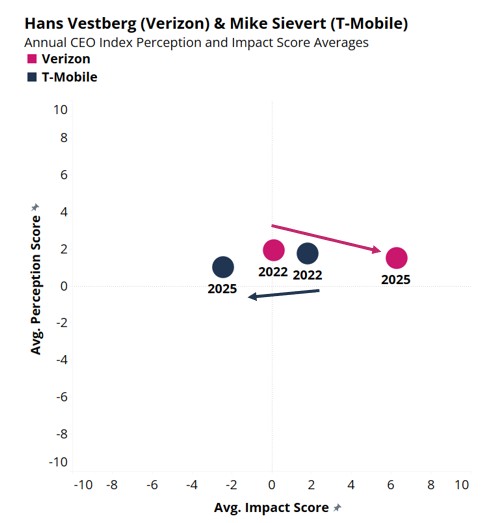
- In the finance sector, several CEOs have successfully shifted archetypes by dialing back personal visibility and focusing on results. Goldman Sachs’ David Solomon, once criticized for his DJ side-gig and off-beat return-to-office comments, retreated from that persona and returned to a more traditional leadership profile. Solomon’s quieter public profile signaled a retreat from Villain territory toward a more stable archetype.
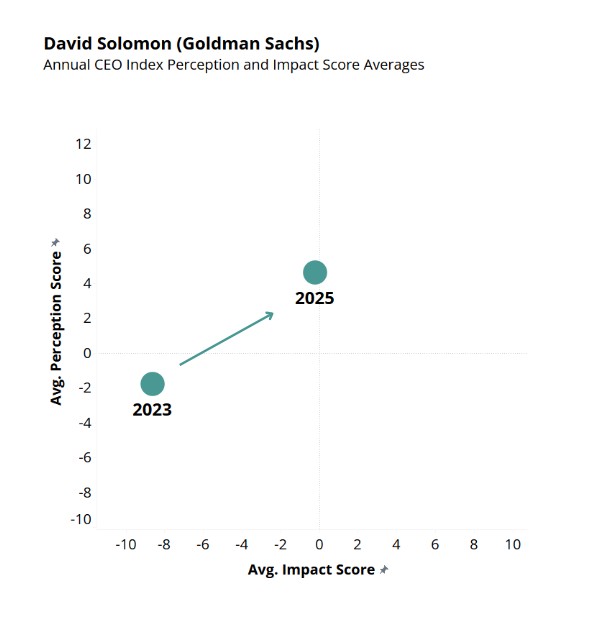
These examples demonstrate that quiet effectiveness is not about avoiding the media altogether, but about ensuring that media coverage consistently reinforces the company’s narrative rather than overshadowing it.
Why Quiet Can Be Effective
Some CEOs score higher on impact than perception. They are not household names like Elon Musk or Mark Zuckerberg, nor do they command constant media attention. Instead, they focus their communication on company performance, innovation, and stakeholder value. Their impact scores suggest that measured visibility, tied directly to the brand’s story, can be just as valuable as charisma or controversy.
This matters at a time when CEOs are under intense pressure to serve as steadying figures. The public looks to them for signals of stability in the face of economic and geopolitical challenges. For executive communications teams, the task is to align messaging with that need, ensuring that even modest media appearances reinforce the company’s strengths and resilience.
Implications for Executive Communicators
The data suggests that visibility alone is no longer a reliable strategy. Executive communications teams should consider:
- Evaluating the CEO’s current archetype and its alignment with company reputation goals.
- Building strategies for high-impact, low-frequency engagements, especially when the CEO naturally fits the Reluctant Hero or Steady Operator mold.
- Monitoring both perception and impact scores over time to identify when a CEO’s presence may be overshadowing or misaligned with the corporate narrative.
- Studying sector-specific examples, such as finance and telecom CEOs, who have shifted archetypes by recalibrating their communications strategies.
Conclusion
Not every CEO will become a larger-than-life media figure, and that can often be for the best. The 2025 CEO Archetypes Index shows that quiet effectiveness can be just as valuable, if not more so, for companies seeking stability and trust. Executive communicators who recognize and support this kind of leadership can help ensure that a CEO’s media presence, however modest, delivers meaningful impact for the brand.
Download the full 2025 CEO Archetypes Report to explore all nine archetypes and learn how they shape both perception and impact.
Author: Kay Kavanagh, Director of Research
Getting Started
Since we last discussed this topic, AI has become a present-day necessity in PR & Communications. But knowing you need to use it and knowing where to begin are two vastly different things.
Many communications leaders feel the pressure to adopt AI but aren’t sure how to start, where to proceed with caution, or what “good” looks like. That’s why PublicRelay is helping clients simply begin by offering a low barrier but extremely strategic way to add AI into their toolkit.
Here’s what we’ve learned from working directly with communications teams using AI every day: what is working, where to watch out, and how a hybrid human-AI approach can help you move forward with clarity.
AI Is Reshaping Communications, But It’s Not a Silver Bullet
Artificial intelligence is now a foundational capability for modern PR and Communications teams. Used strategically, AI is reshaping how communicators gather insights, track narratives, and respond to risk. But we’ve seen firsthand: AI is only as strong as the strategy—and human expertise—behind it.
On its own, AI lacks the context, precision, and strategic nuance required to meet the high stakes demands of today’s media environment. That’s why the most effective PR teams are embracing a hybrid model that combines the speed and scale of AI with the insight and accuracy of human expertise.
Opportunity: Scale and Speed in a Noisy World
Every minute, millions of posts, photos, and videos are shared, viewed, and watched across social media channels like X, Instagram, TikTok, and YouTube. Joining nearly a million news articles published each day, the scale of public discourse becomes overwhelming. Parsing this vast landscape for relevant content, sentiment, stakeholder impact, and reputational risk is far beyond the capabilities of traditional manual analysis.
This is the clearest value of AI: helping communications teams keep pace with an information environment that simply moves too fast for humans alone.
Its ability to process and classify massive volumes of unstructured data quickly makes it ideal for surfacing high-level trends, monitoring message pickup, benchmarking competitors, and identifying sudden shifts in tone or topic. This kind of speed and scale is essential to helping communicators respond with agility and insight.
Pitfall: The Context Gap
Yet AI has limitations. Despite its speed and efficiency, it lacks the bespoke context and strategic understanding that communications leaders rely on to make high-quality decisions. AI models can hallucinate. They can miss nuance. And they struggle with the ambiguity and complexity that often define reputational risk or opportunity.
That’s why leading communications functions aren’t replacing human expertise, they’re strategically augmenting it. A hybrid model that pairs AI with human intelligence offers the best of both worlds: scale without sacrificing relevance. Humans continue to play a vital role in interpreting data, validating insights, and applying contextual understanding that machines alone can’t deliver.
PublicRelay helps clients walk that line, giving them confidence to start their AI journey knowing they’re supported by both responsible AI use and human judgment.
Start Here: Smart Ways to Add AI to Your Communications Toolkit
You don’t need to be an expert or completely overhaul your workflow to begin using AI. Here are a few ways PublicRelay is helping clients integrate AI responsibly:
Media Measurement at Scale
AI enables us to track and measure media coverage across millions of sources. Key messages, executive visibility, peer comparisons, and issue-based trends can all be monitored with speed and consistency. Human oversight ensures the accuracy and relevance of that data, especially when it comes to interpreting tone, intent, or subtle shifts in narrative.
Narrative Intelligence
Advanced AI models can now help identify not just what’s being said, but how topics are connecting across the media landscape. By surfacing patterns in sentiment, stakeholder voice, and narrative evolution, our team can help communicators spot emerging storylines, understand how public opinion is forming, and map the themes likely to dominate coverage.
Predictive Signals and Risk Detection
One of the most powerful developments in AI for communications is predictive modeling. By examining real-time indicators alongside historical media trends, AI can flag stories likely to accelerate in visibility (whether they represent a reputational risk or a positive opportunity). Early warning systems give communications leaders the ability to prepare responses, shape narratives, and steer internal alignment before the conversation takes off.
We’ve seen this approach help clients properly navigate media crises and also spot moments of opportunity early.
Custom Intelligence for Strategic Alignment
AI is most effective when its capabilities are tailored to the unique context of a business. Communications teams are increasingly building custom analysis frameworks aligned to their structure, goals, and stakeholders. We work with our clients to design bespoke AI applications that mirror their internal priorities, whether that means tracking specific narratives, evaluating executive visibility, or benchmarking key competitors.
Think of this as turning AI into your AI.
A Feedback Loop for Continuous Improvement
The most successful implementations of AI in PR evolve. Human experts serve as the feedback mechanism that keeps AI models accurate and relevant, particularly as business objectives shift or media landscapes change. This consistent feedback loop is a core part of how we ensure our clients’ insights remain both actionable and aligned with what matters most to their organization.
You Don’t Have to Be First, You Just Have to Begin
If you’re not already using AI, you’re not behind, you’re just ready to start. At PublicRelay, we’ve seen that the most successful teams aren’t the ones who jump headfirst into AI with flashy tools. They’re the ones who take a smart, strategic first step that aligns with their needs and grows over time.
The Future of Communications Is Hybrid
The future of Comms is about combining the precision of people with the power of technology. AI enables communications teams to scale analysis, anticipate emerging narratives, and respond with agility. Human expertise ensures that what’s surfaced is meaningful, accurate, and strategically useful.
In a world where the pace of information shows no signs of slowing, this hybrid approach should be standard. It transforms communications teams into strategic advisors equipped not just to monitor what’s happening but to shape what happens next.
You don’t have to master AI overnight. But you can start building a smarter, more proactive PR function.
Want to explore how AI can support your communications goals without overcomplicating your workflow? Let’s talk.
PublicRelay partners with leading brands to deliver the insight and clarity their teams need to lead.
Author: Liz Hogan, Senior Solutions Engineer
Communicators are under increasing pressure to prove the value of their earned media efforts. But what makes media coverage truly valuable?
For years, the industry has leaned on metrics like volume, impressions, and AVE, numbers that often favor quantity over quality. While these metrics have their place, they fall short of capturing the true impact of media coverage. The ever-present push to prove value requires a shift in the conversation from how much coverage you’re getting to how much it actually matters.
Beyond Volume: Defining Media Value
True media value lies in context, quality, and strategic relevance. A single mention in a high-authority outlet that aligns with your brand’s key messages can be more impactful than dozens of low-quality clips. To understand this deeper value, we need to look at media coverage through a more sophisticated lens that considers not just visibility, but significance.
PublicRelay’s Media Quality Score (MQS) does that.
By combining five dimensions of media quality into one metric, MQS offers a contextualized, actionable view of media performance.
The Five Dimensions of Media Quality
To succeed in the GEO era, comms teams must rethink how they craft and distribute content. Here are four strategies to get started:
1. Outlet Credibility
Not all media outlets are created equal. Communicators should be able to assess the authority and prominence of the source, whether it’s a national publication, a respected trade journal, or a niche blog.
Example: A feature in The Wall Street Journal carries more weight than a mention in a low-traffic blog. Knowing definitively which outlet(s) move the needle most helps you prioritize higher-impact placements.
2. Topic Incidence
This measures the depth and richness of coverage. It’s not just about being mentioned; it’s about how thoroughly your brand is discussed and whether your strategic messages are front and center.
Example: An article that explores your company’s innovation strategy in detail would score higher than one that simply lists your name among competitors.
3. Tonality
Unlike machine-generated sentiment scores, MQS uses human analysts to evaluate tone with nuance and context. It also compares your brand’s tone to that of competitors.
Example: If your brand is portrayed more positively in a direct comparison to a peer, that’s more impactful than simply getting listed side-by-side in the same context.
4. Social Engagement
Earned media doesn’t stop at publication. MQS tracks how much traction your coverage gets on platforms like Facebook, X, and Pinterest.
Example: A story that sparks conversation and shares on social media amplifies your reach and influence.
5. Distribution
This component evaluates how widely an article is syndicated and republished.
Example: An article picked up by a wide syndication network and republished across industry sites has broader reach and impact than a single publication.
Media Quality Score: A Holistic Solution for Strategic Communicators
In sum, MQS is a strategic compass that helps communications leaders:
- Benchmark performance over time and against competitors
- Identify strengths and weaknesses in media strategy
- Present clear, compelling results to executives
- Focus efforts on what truly moves the needle
In a world where media noise is constant, MQS helps you tune into the signals that matter most, making it easier to understand the value your team is bringing to the table.
Contact the PublicRelay team to learn more about our Media Quality Score.
Author: Medha Chandorkar, VP of Product Management